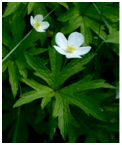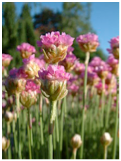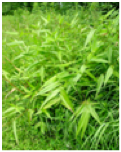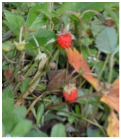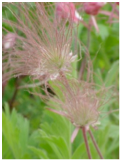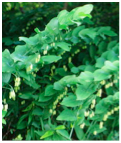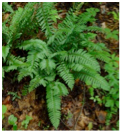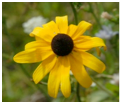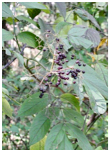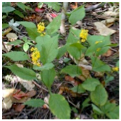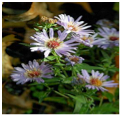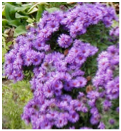The Anderson Bridge Parkette
A Sustainable Garden Plant List
In 2011, Oakville Horticultural Society planted over 630 plants and shrubs, representing 48 North American species, 35 indigenous to Halton. The following is a listing of the current plantings and their care. .
|
|
Agastache foeniculum Giant Hyssop (Family – Lamiaceae) Height 60-120cm; blooms Jul to Aug in purplish blue. Cut back stems in early spring (or late fall) with bypass pruners. Leave 4 to 6 inches remaining to promote bushier growth next season. Cut off flowering stems when they are finished to the first set of leaves. This will produce more flower stems.(Indigenous to Halton) |
|
|
Amelanchier arborea Downy Serviceberry (Family – Rosaceae) Height 5-12m; blooms white in spring. Serviceberry plants normally do not need to be pruned for the first three years. During the fourth year, the dormant plants should be pruned in mid-March. Remove dead and weak branches and thin, terminal wood with small buds. Prune interior crossing branches to admit light to the center of the plant. In subsequent years, thin out older branches to force new growth. Tall-growing branches can be headed back and thin branches removed. Flower buds of serviceberry bush are produced on tips and down the second year old shoots (Indigenous to Halton) |
|
|
Anaphalis margaritacea Pearly Everlasting (Family – Asteraceae) Height 30-90 cm; blooms Jul to Sept cream to white. It requires little care. Can be cut back in late fall or early spring. Consider pinching back the stem ends in spring to reduce mature plant height if they tend to become leggy.(Indigenous to Halton) |
|
|
Andropogon gerardii Big Bluestem (Family – Poaceae) eight 100-200 cm; blooms Aug to Sept. This warm season grass is a slow spreading sod forming grass fine to medium blue-green blades. It is best to cut back in spring to enjoy colourful seed heads over winter and provide food for wildlife. (Indigenous to Halton) |
|
|
Anemone canadensis Meadow anemone (Family – Ranunculaceae) Height 15-80cm; blooms Apr to Aug in white. This plant requires little care, but can become aggressive. If clumps become crowded flowering will decrease. It should be divided in the fall. Seed heads are attractive but should be removed if self sowing becomes a problem. (Indigenous to Halton) |
|
|
Aquilegia canadensis Canadian Anemone (Family – Ranunculaceae) Height 30-90 cm; blooms from Apr to Jul Yellow, Red, Pink. Crowns can rot in very wet seasons. Cut back old seed heads and stems in summer to keep tidy looking as desired. Leave seed heads and watch for seedlings if more are desired. (Indigenous to Halton) |
|
|
Arctostaphylos uva-ursi Bearberry (Family – Ericaceae) Height 10-30cm; blooms Mar to Jun in white to pink. To maintain, prune to thin out dead or dying wood over time. (Indigenous to Halton but regionally rare) |
|
|
Armeria maritima Thrift Seapink (Family – Plumbaginaceae) Height 10-30cm; blooms Mar to Jul in purplish pink. Dead-heading will prolong flowering. Division should be performed in early spring and is necessary to rejuvenate the plant.(Provincially rare native introduced in Halton) |
|
|
Aronia melanocarpa Black Chokeberry (Family – Rosaceae) Woody shrub 1-2m high and wide; blooms mid May in white followed by dark blue berries. Sun to part shade but may become leggy and be affected by mildew in dark corners. Beautiful fall color. High tolerance to drought, salt and soil compaction. Prune late winter to maintain shape.(Indigenous to Halton) |
|
|
Asarum canadense Wild Ginger (Family – Aristolochiaceae) Height 10-15cm ; blooms Apr to Jun in purplish brown. This is a pretty care free ground cover. Summer cuttings and fall root division are best for propagation. (Indigenous to Halton) |
|
|
Asclepias tuberosa Butterflyweed (Family – Apocynaceae) Height 30 to 45cm; blooms May to Sep in bright orange. They have taproots and resent disturbance. Asclepias is a prolific self-seeder and should be deadheaded if self sowing becomes a problem. It winters better if the foliage is allowed to protect the crown.(Indigenous to Halton) |
|
|
Cercis Canadensis Eastern Redbud (Family – Fabaceae) Height 4-9m; blooms in Mar to May in purplish pink. Prune dead wood and shape after flowering. (Native to Eastern United States, introduced to Halton) |
|
|
Chelone lyonii Turtlehead (Family – Asteraceae) Height 1-2m; blooms Aug to Oct in purplish pink. Consider pinching back the stem ends in spring to reduce mature plant height if they tend to become leggy. They seem to fare better if allowed to stand during the winter and cleaned-up in the spring. (Native to Eastern United States, introduced to Halton) |
|
|
Cystopteris bulbifera Bulblet Fern (Family – Cystopteridaceae) Height 15-30cm. Should flourish without care or attention. Thin out as needed. (Indigenous to Halton) |
|
|
Cornus racemosa Grey Dogwood (Family – Cornaceae) Height 1-4 m; blooms from May to July in cream then produces berries in summer. Head-back and renewal prune as needed in late summer or early spring. Can take hard pruning. (Indigenous to Halton) |
|
|
Dasiphora fruticosa (syn. Potentilla ) Shrubby Cinquefoil (Family – Rosaceae) Height 30-130 cm; blooms from Jun to Sept in bright yellow. This requires very little pruning, but it is a good idea each autumn to trim the bush to shape and remove any straggly shoots. Older neglected plants can be cut to 30cm (1ft) from the ground to re-invigorate them. (Native to Ontario – introduced to Halton) |
|
|
Dichanthelium clandestinum (syn Panicum clandestinum) Deer Tongue Grass (Family – Poaceae) Height 45cm to -115cm; blooms from May to Sept silvery flower heads that age to brown. This clump forming perennial grass with pale grey to deep green leaves should be cut back before the new growth starts to appear, but after the cold weather is over. Cut back to about 8 to 10cm from the crown of the plant. Very shade tolerant and bamboo-like. (Indigenous to Halton) |
|
|
Echinacea pallida Pale Coneflower (Family – Asteraceae) Height 90-120 cm; blooms Jun to Jul in purplish pink. Prune minimally for best results. To extend their blooming season, remove fading flower tops to encourage new buds to form or permit the declining blooms to dry on the stems and remain after first frost to provide food for migrating songbirds in winter.(Provincially rare – Indigenous to Halton) |
|
|
Erythronium americanum Trout Lily (Family – Liliaceae) Height 10-12 cm; blooms Apr to May in yellow. This spring ephemeral comes up early, early spring and will completely die back by June. Bulbs can be spread in fall.(Indigenous to Halton) |
|
|
Fragaria × ananassa Garden Strawberry (Family – Rosaceae) Height 5-10cm; blooms all summer in white. This everbearing strawberry is a day-neutral hybrid variety. Mulch will protect the plants from cold temperatures that can kill the buds and injure roots and crowns and keep the fruit from soil contact.(While Fragaria viginiana and F. vesca are indigenous, this hybrid cultivar is introduced to Halton) |
|
|
Gaillardia aristata Blanket Flower (Family – Asteraceae) Height 60-90cm; blooms Jul to Sept in red and yellow. Deadheading can improve appearance and lengthen bloom time, but it should be allowed to self sow as it is a short-lived perennial. (Native to North America – introduced to Halton) |
|
|
Geum triflorum Prairie Smoke (Family – Rosaceae) Height 20-40 cm; blooms May to Jun in purplish pink. This is a low care ground cover. Geum builds itself up to a ferny evergreen clump of bright green. Can be divided in fall. Leave seed heads as they are highly decorative. (Native to North America – introduced to Halton) |
 |
Juniperus communis var. depressa aurea Golden Flat Juniper (Family – Cupressaceae)
Height 30-60cm with a 1-3m spread if not pruned back. They should require very little maintenance, and take light pruning quite well. (While this species is regionally rare – this cultivar is introduced to Halton) |
 |
Juniperus virginiana Eastern Red Cedar (Family – Cupressaceae)
Height 10 to 20m. This small tree with a dense ovoid or columnar crown should require very little maintenance. It can take light pruning quite well – but not hard pruning.(Indigenous to Halton) |
 |
Helenium autumnale Sneezeweed (Family – Asteraceae)
Height 60-150 cm; blooms from Aug to Oct yellow to orange and red. They can be cut back hard before July to keep shorter bushier habit and pruned back in spring. (Indigenous but regionally rare) |
 |
Hepatica nobilis Round Lobed Hepatica (Family – Ranunculaceae)
Height to 30cm; blooms Mar to Apr in white to pink to blue. This spring ephemeral requires no care. (Indigenous to Halton) |
|
Liatris spicata Blazing Star (Family – Asteraceae)
Height 30-180 cm; blooms from Jul to Nov in pinkish purple. The clumps may be easily divided every 3 to 4 years in the spring. (Provincially rare – introduced to Halton) |
|
|
|
Mahonia aquifolium Oregon Grape (Family – Berberidaceae) Height 2-4m; blooms Mar to May with yellow flowers followed by blue fruit. Prune in late winter or early spring after the fruit has all been taken. Remove any dead, broken, diseased canes by severing them at the crown of the plant at the soil line with sharp, clean secateurs. Reduce the height or spread of the shrub by removing the oldest and longest canes that jut out beyond the desired size, line or shape of the shrub. Remove up to one-third of the total shrub volume each year to control the shape and size as needed.(Native to North America – introduced to Halton) |
|
|
Monarda fistulosa Wild Bee Balm (Family – Laminaceae) Height 60-120 cm; blooms Jun to Aug in purplish pink. After plants have finished flowering and foliage begins to decline, cut the plants all the way back to the ground – this hard pruning will often result in a second round of flowering. Can be aggressive. Divide plants every three years to keep them looking their best. Powdery mildew will be a problem and can be reduced with weekly milk or yogurt sprays in late spring.(Indigenous to Halton) |
|
|
Parthenocissus quinquefolia Virginia Creeper (Family – Vitaceae) Vine 5-20m; blooms Jun to Aug followed by blue berries. It should be pruned and trailed as needed to keep it in the space desired. (Indigenous to Halton) |
|
|
Phlox subulata Creeping Phlox (Family – Polemoniaceae) Height under 30cm; blooms Mar to June in purplish pink. This ground cover should form an evergreen mat and should require little care. Pinching back after blooming with make them denser. Division is best immediately after blooming. (Indigenous to Halton) |
|
|
Polygonatum biflorum Solomon’s Seal (Family – Ruscaceae) Height 30cm to 2m; blooms March to June in white followed by blue black berries. They should require little care. (Indigenous to Halton but rare) |
|
|
Polystichum acrostichoides Christmas Fern (Family – Dryopteridaceae) Height 30-75 cm. This indigenous evergreen fern should require little care. |
|
|
Pulsatilla patens Eastern Pasqueflower (Family – Ranunculaceae) Height 15-35 cm; blooms from Apr to Jun in purplish blue. This requires no special care. May go dormant in drought. (Provincially rare – introduced to Halton) |
|
|
Rudbeckia hirta Brown-Eyed Susan (Family – Asteraceae) Height 30-150cm; blooms from Jun to Oct in yellow. Cut back in spring (or late fall). These require little care. (Indigenous to Halton) |
|
|
Rudbeckia lanciniata Green Coneflower (Family – Asteraceae) Height 1-2m; blooms from July to Sept in yellow. Since the habit can be floppy, it can be pinched back in June to promote bushiness. A vigorous spreader, this may need to be reduced in size in spring. (Indigenous to Halton) |
|
|
Sambucus canadensis Elderberry (Family – Adoxaceae) Height 1 – 6m Bloom; blooms from May – Jul with creamy white flowers followed by purplish black berries. They have shallow roots so avoid disturbing the soil around the shrub. Flowers and fruit develop on the tips of the current season’s growth, often on the new canes but especially on laterals. Second-year elderberry canes with good lateral development are the most fruitful. In the third or fourth year, older wood tends to lose vigor and become weak. In late winter to early spring while the plants are dormant, remove all dead, broken or weak canes, plus all canes more than three years old. Leave an equal number of one, two, and three-year-old canes. (Indigenous to Halton) |
|
|
Senna hebecarpa (syn. Cassia) Wild Senna (Family – Fabaceae) Height 1-2m; blooms in Jul to Aug in yellow followed by bean-like seed pods. Can be pruned to shape and create a bushier form. (Provincially rare – introduced to Halton) |
|
|
Solidago flexicasuli Zigzag Goldenrod (Family – Asteraceae) Height 30-100cm; blooms from Sept to Oct in yellow. Cut it back in spring for tidy appearance if desired. Requires little care. (Indigenous to Halton) |
|
|
Solidago rugosa Rough Goldenrod (Family – Asteraceae) Height 30-120cm; blooms from Sept to Oct in yellow. Cut it back in spring for tidy appearance if desired. Requires little care. Cultivar: ‘Firecracker’. (Indigenous to Halton) |
|
Sorgastrum nutans Indian Grass (Family – Poaceae) Height 1.5-2m; blooms Jul to Oct. This warm season, sod forming grass should spread slowly. Cut back before the new growth starts to appear, but after the cold weather is over, to about 10cm from the crown of the plant. (Native to Ontario – introduced to Halton) |
|
|
|
Symphyotrichum ciliolatum Lindsey’s Aster (Family – Asteraceae) Height 1m; blooms in fall in lavender to purple. Pruning off one half to two thirds of the growth in June will result in a bushier plant with more, though smaller, flowers. Clean up is preferable in spring. (Indigenous to Halton) |
|
Symphyotrichum novae-angliae New England Aster (Family – Asteraceae) Height 1-2m though cultivar ‘Purple Dome’ should have more compact growth e.g. 50-60cm; blooms from Aug to Oct in Pink, Purple. The cultivar “Purple Dome” is more compact in habit but can revert. Remove reversions and prune off one half to two thirds of the growth in June to create a bushier plant. (Indigenous to Halton – cultivar introduced) |
|
|
|
Viburnum lentago Nannyberry (Family – Adoxaceae) Height to 5-9 m; blooms from May to June with creamy white flowers, followed by bluish-black fruit. Slow growth rate should require minimal pruning. Renewal pruning and heading-back should be done after flowering; older plants can be rejuvenated in late winter or early spring. (Indigenous to Halton) |
|
|
Verbena hastata Blue Vervain Height 60-180 cm; blooms Jun to Sep with bluish purple flowers. This requires little care. Cut back in spring and clean up spent blooms as desired. (Indigenous to Halton) |
|
|
Veronicastrum virginicum Culver’s Root (Family – Plantaginaceae) Height 90-180cm; blooms from Jul to Sept in white to blue. Divide in spring or fall. (Provincially rare – introduced to Halton) |
|
|
Waldensteina fragariodes Barren Strawberry (Family – Rosaceae) Height. 10-20cm; blooms from Apr to Jun in yellow. This low growing ground cover should require little care. Divide as needed spring or fall. (Indigenous to Halton) |
|
|
Yucca filamentosa Adam’s Needle (Family – Agvaceae) Height 50-100cm; blooms from May to Jun in cream. Divide as needed spring or fall. |





